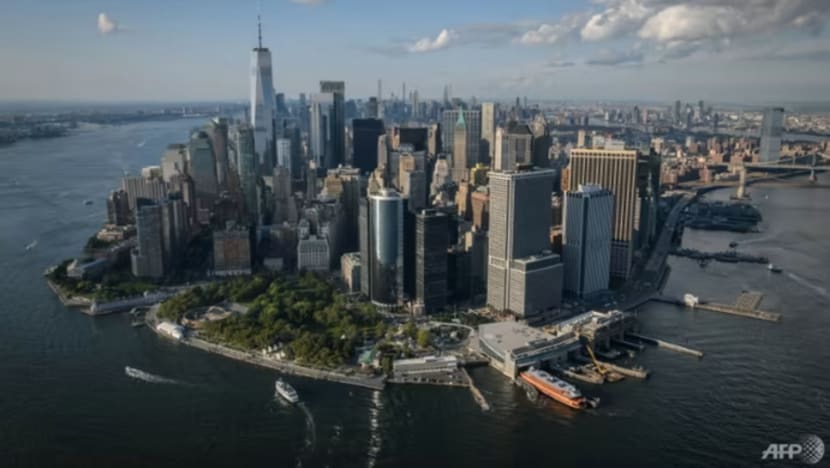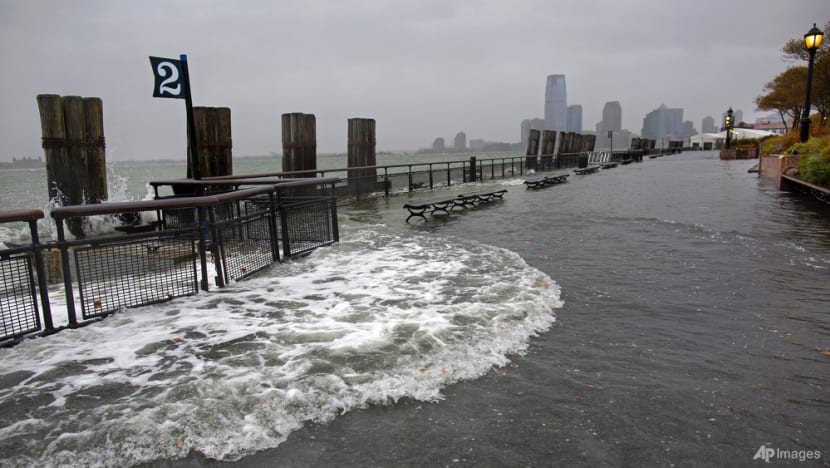New York City is sinking under the massive weight of its skyscrapers
Researchers, who found that New York City is sinking under the weight of its buildings, said developers are not taking the risk of rising waters seriously enough.

Lower Manhattan skyline and New York city (Photo: AFP/Ed Jones)
NEW YORK CITY: The city of New York is sinking.
New research has revealed that the combination of massive skyscrapers and a rising sea level could make the city more prone to natural disasters.
However, researchers said developers are not taking the risk of rising waters seriously enough, and this could spell trouble for the over 8 million residents of the city in the future.
A team at the University of Rhode Island took on the daunting task of estimating the total weight of the more than 1 million buildings that make up New York City.
They found that almost 1 trillion kg of concrete, steel and glass are pushing down the ground, causing it to slowly sink lower towards sea level.
At the same time, the sea level is increasing due to global warming and climate change.
The global mean sea level has risen an estimated 10cm since 1992, according to NASA.
It is projected to continue to rise between 20cm and 75cm in the next 25 years.
HOW FAST IS NYC SINKING?
The rate at which New York City is sinking varies throughout the city, according to the research.
The famed eight-block-long Wall Street in the financial heart of New York is just 1 to 2m above sea level.
Midtown Manhattan is built on rock, which compresses very little. However, Brooklyn and Queens have looser soil, which causes the sinking to happen faster.
Parts of Lower Manhattan were artificially expanded by land reclamation near the coastline, making the ground more vulnerable to gravitational forces from the weight of the buildings because it is not as compact as natural landscape.
As a result, some of the land there is sinking twice as fast, at a rate of up to 4mm per year.
POLICIES NEED TO CHANGE
Researchers said that while it is not yet an emergency, they want to provide the science to help with future planning.
“This is where the policy comes into play. This is where we have the responsibility to integrate this data, this science, with other science and climate science, and talk about the impacts,” said Mr Andrew Kruczkiewicz, a senior researcher at Columbia University’s Climate School.
Residents in the city, which has seen some devastating floods in the last few years, agree.
“Frankly, I was a little surprised after Hurricane Sandy that more wasn't done because so many homes were destroyed. Places like apartment buildings in the city suffered,” said one New Yorker.
In 2012, Hurricane Sandy tore through New York City, killing 44 people, destroying thousands of homes and infrastructure, and inflicting an estimated US$19 billion in damages.

“Going forward, we need to be looking to policymakers to think about climate change, resilience and risk mitigation,” said another resident.
Every additional high-rise building along the water might contribute to future flood risks, researchers cautioned.
However, construction is showing no signs of stopping.
The same waterfront areas that bore the brunt of the devastation from Hurricane Sandy and the more recent flash floods have seen some of the highest rates of new housing developments.
A CITY WITH A LOT AT STAKE
The city, which has some of the most expensive land in the United States, stands to lose a lot as rising seas continue to erode the shore, said observers.
“As we look around the country, we are talking about a significant amount of money essentially lost to the rising seas,” said research organisation Climate Central’s vice president of communications Peter Girard.
“In the New York area, as we project to 2050, the amount approaches US$1 billion.This is not the retail value of land but the tax-assessed value. This value supports property taxes and all of the municipal services dependent on those.”
The city ranks third in the world in terms of the value of real estate assets exposed to coastal flooding, after Guangzhou and Miami.
This could mean big losses for owners and investors if natural disasters hit.
Yet, research has shown that some 90 per cent of buildings at risk of damage are not up to flood resilience standards.
FEW SAFEGUARDS IN PLACE
The city has features that help protect structures from floods, such as mechanical water pumps.
While some developers have started building these safeguards in — especially those that rely on government financing as it is often a requirement – the majority still do not, due to added cost.
Often, companies are reluctant as they see no financial incentives to do so.
“These are businesses, and they try to minimise expenses. Like, why did you spend extra money this year? Can you charge more rent for it? Sometimes, but not always,” said Legacy Real Estate Development chief executive officer Jerrod Delaine.
He added that change has to start at the government level, or through insurance policies or lenders.
“Seat belts had to become a law before we all wore seat belts, right? Although we all knew it saves lives. But people didn't necessarily do it. Now that it’s a law, everybody does it,” he said.
New York has led the way in other aspects of green infrastructure, like regulation around buildings’ carbon emissions.
However, there are no laws surrounding flood prevention – a gap experts say needs to be plugged as soon as possible.
“It would be better to do it now versus just kind of postponing everything. But with the caveat that not all the buildings can be rebuilt now,” said Ms Vrinda Mittal, a PhD candidate at Columbia Business School.
Industry observers said they expect stricter regulations soon, as New York looks for ways to protect its iconic skyline from the rising seas.














